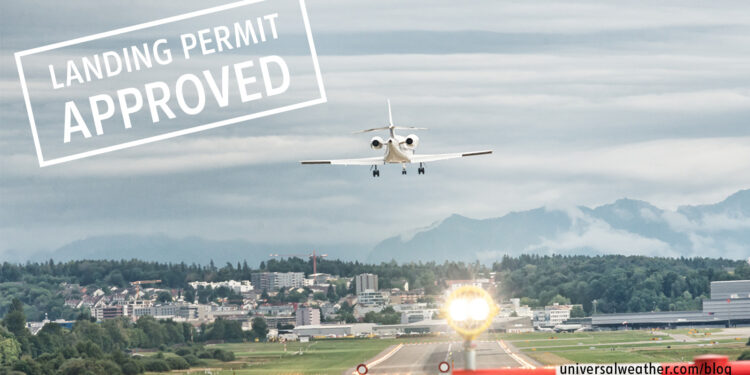The Definitive Guide to Requesting Flight Permits, Part 1

This business aviation blog post is part one of a two-part series on requesting flight permits.
Permit requirements for overflight and landing vary by country and type of business aircraft operation. While documentation and lead-time requirements are fairly standard at many locations, they can be more challenging at others. Always confirm latest permit documents requirements and procedures well in advance of your trip. Permit requirements change, and at certain locations you’ll need to provide non-standard documentation and/or allow for longer lead times.
1. Follow this basic process for requesting flight permits
Determine if you’re operating as private or charter (non-scheduled commercial) to know which type of permits to apply for. The next step is to figure out the safest and most cost effective route to your destination. Determine the countries that require overflight and landing permits based on your route and gather all necessary information for the permit requests. Make sure that your planned route is valid and that your operations specifications and insurance do not restrict you from overflying or landing at a particular country. Read your entire insurance document, not just the synopsis. Check current regulations regarding sanctioned countries if you’re a U.S. operator or utilizing a U.S. 3rd-party provider. Also, ensure there are no outstanding navigation charges owed for your aircraft, as this can hinder your permit request.
2. Do not use random routes for permits
You should use routes that have been carefully checked to make sure they’re valid. Go through your charts to ensure valid routes. Do not use random routes. If entering or leaving Europe, always validate the proposed route through Eurocontrol. Also, some countries will not permit you to use DCT points.
3. Some regions require more permits than others
Africa and Asia are good examples of permit intensive regions. Every country in Africa requires a permit, and operators may miss permits from time to time. In some countries, such as Senegal, you’ll need a permit when entering a Flight Information Region (FIR), even though you’re not actually overflying the country. China and Mongolia are particular with routings and require use of entry and exit points at specific times. Russia is also particular regarding routings and entry/exit points. India generally requires more lead time on permit requests and is stringent on minimum lead times. China may ask you to revise a route due to anticipated airway congestion, and this can impact other permits like Mongolia and Russia. There are cases where one permit is approved and another rejected due to routing issues, and this can result in multiple permit revisions. We recommend you read this post by Larry Williams entitled 10 Potentially Challenging International Permits for Business Aviation Operators.
4. Private (non-revenue) and charter (non-scheduled commercial) flights will typically follow different permit application processes
Charter permits usually require more lead time and operators must provide more documentation in regards to aircraft and crew. Private non-revenue flights do not require permits for Germany, France, Italy, UK, or Switzerland, but permits are needed if you’re operating as a charter. Japan requires permits for charter, but not for private non-revenue operations. Some countries – Germany for example – are particular regarding documentation furnishing in terms of charter permits.
5. The processes for requesting overflight and landing permits are usually different
Both landing and overflight permits are equally important to have before the flight, but landing permits usually require more lead time and more information. Overflight permits require standard information such as aircraft type, registration, call sign, schedule, operator name, route, FIRs when applicable, captain’s name, crew and passenger count, and billing information. Landing permits require the same information as overflight permit, but usually require a full crew and passenger manifest to include passport information and business contacts when applicable at each destination. Additional information may be required for overflight and landing permits, depending on the requirements of that Civil Aviation Authority (CAA). Both China and Saudi Arabia landing permits require sponsor information, and they’ll usually verify this information appropriately. Occasionally, you’ll experience rare and non-standard documentation requests. The Philippines CAA requires a color photo of your aircraft showing tail number in PDF format to approve a landing permit. Bolivia requires the operator’s company logo on permit requests as well as a signature of the pilot or a company officer. For a domestic Brazil landing permit, both pilots must have ATPs issued by the country the aircraft is registered in.
6. These are the most common items you’ll need for requesting permits
- Insurance certificate
- Registration certificate
- Airworthiness certificate
- Air Operator Certificate if it’s a charter flight
- Noise certificate
- Pilot licenses
- Medical certificates (may require 1st class medical certificate depending upon the country)
- Crew and passenger passport details
7. Each CAA has its own special format requirements for permit requests
Many countries require specific information in formats tailored to the appropriate Civil Aviation Authority (CAA) requirements. In some cases, such as Israel landing permits, specific applications must be filled out. Your 3rd-party provider should have permit request formats available for each country. In some cases, with modifications such as a passenger or schedule change, the entire permit request will need to be resubmitted.
Questions?
If you have any questions about this article, contact me at jimemerson@univ-wea.com.
Later, we’ll discuss permit revisions, agencies involved in the permit process, short-notice permits and other things you should know.




